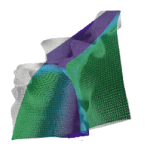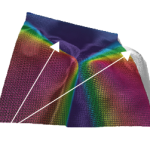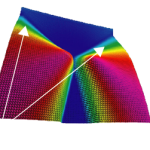BES – BALANCE EYE SMOOTHING
The problems related to the adaptation in the use of progressive lenses are mainly due both to the aberrations present both in the progressive areas of vision (far. near and channel), and to those present in the peripheral areas, which force the wearer of glasses to unnatural movements of the head.
The poor sharpness limits of the peripheral vision areas are due to the integration of the different geometries of the distant area and the near area, thus creating not only high astigmatism values, but also a lot of non-homogeneity of the cylinders. These fluctuations in values, when reading the maps, show themselves as ‘waves of the sea’.
In nature, the more waves there are in the sea. the more agitated it appears to us. The higher the waves, the more there is a storm.
In progressive lenses it works the same way. the more sudden changes in astigmatism there are and the more you have vision difficulties, the higher the astigmatism values are and the more you experience lens wear problems, such as headaches and nausea.
The Opto+ designs, thanks to the mathematical methodologies applied natively in the design phase, have always guaranteed a sharpness of the progressive areas (Far. near and channel) close to 9996. Perceived astigmatism is therefore tending to 0.
In recent years, the Opto + innovation team has focused on optimizing vision in the peripheral areas and Balance Eye Smoothing (BES) technology is the result of this research.
The BES combines different mathematical techniques that allow you to keep the average values of power and the values of astigmatism under control, standardizing them as much as possible within the peripheral areas. In this way. average astigmatism values are obtained that do not disturb binocular vision.

Traditional lenses
The different areas are presented in a disconnected and non-uniform way

Opto+ lenses
Thanks to our Mathematical algorithms progressive zones are balanced and smoothed.

Traditional lenses
Angular and uneven areas

Opto+ lenses
Softening in the assages between near andfar areas to avoid the tooth effect
The Opto+ designs, thanks to the mathematical methodologies applied natively in the design phase, have always guaranteed a sharpness of the progressive areas (Far. near and channel) close to 99%. Perceived astigmatism is therefore tending to 0.
This intrinsic flexibility of the design offers the laboratory the advantage of customizing the design even when defining the commercial offer, using the same design with differ ent width parameters for different purposes of using the lens

